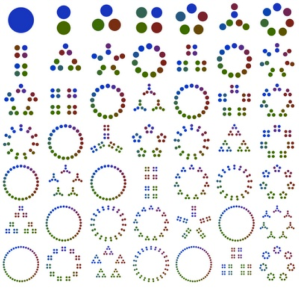 Are you interested in factoring, prime numbers, and composite numbers? If so, this is the link for you!
Are you interested in factoring, prime numbers, and composite numbers? If so, this is the link for you!
Not long ago someone posted this link on the BCAMT list serve. When I first accessed the link I was fascinated as I watched the progression of dots on my screen, each representing the next natural number. The configuration of each number of dots revealed information about the make-up of that particular number.
It made me wish that I had had access to such a visual when I was teaching about factoring, prime numbers, and composite numbers. I thought I would pass the link on to you folks as I know some of you are, indeed, teaching these concepts associated with number theory.
Many of you will be familiar with exploring these particular concepts through the process of creating rectangles from square tiles. In this method, for example, seven can be shown to be prime because seven square tiles can be made into only one rectangle: 7 x 1. Eight, however, can be shown to be composite because eight square tiles can be made into more than one rectangle: 8 x 1 and 4 x 2.
The visual presented here offers another way for students to literally see whether or not a number is prime, and, for those which are not prime, to be able to deduce some or all of the factors from the grouping of the dots.
I hope you will use the link and the accompanying picture here to explore primes, composites, and factors.
Here is the link to the animated factorization diagrams.
Mathematically yours,
Carollee
PS: Thanks Kelli Holden for commenting on the picture and sending along a link to Malke Rosenfeld’s blog where the picture has been turned into a game! Check out this link.
Isn’t Maths pretty?! Are you happy if I share this picture on my blog with a link to your post? I recreated the first eight numbers with my seven year old son using rocks outside. I asked him if we could make four out of another number (not including 1) which he did using the two. He deduced that five couldn’t be made from another number. We looked at the other ‘circle’ numbers and he realised that they also couldn’t be made from other numbers. He thought he noticed a pattern that all odd numbers (or every other number as he put it) were ‘circle’ numbers. We explored this hypothesis with more rocks but he quickly realised at nine that this wasn’t the case. I told him that the ‘circle’ numbers were called prime numbers and the other numbers were called composite numbers. This is such an amazing tool for discovery learning of prime and composite numbers. Thanks for posting. Another great visual representation of numbers that my kids love is an app called ‘DragonBox numbers’ – I am not affiliated in any way to the creators, I just know my sons loved it!
Yes feel free to share. It did not originate with me — I passed it on, too!
This is so beautiful – thank you for sharing it! I’m using it in a class on cryptography tomorrow!
[…] and 5 can be seen as ice-cream spoon. Or if you prefer another representation like this … https://focusonmath.wordpress.com/2013/01/08/factoring-a-visual-representation-of-numbers/ it’s […]
I loved the diagram as well, and was excited to find this game it inspired on Malke Rosenfeld’s blog
http://mathinyourfeet.blogspot.ca/2012/11/new-math-game-factor-dominoes.html
Enjoy!
Thanks, Kelli — I will edit the blog and add this link right in (since I am not sure everyone reads the comments!)